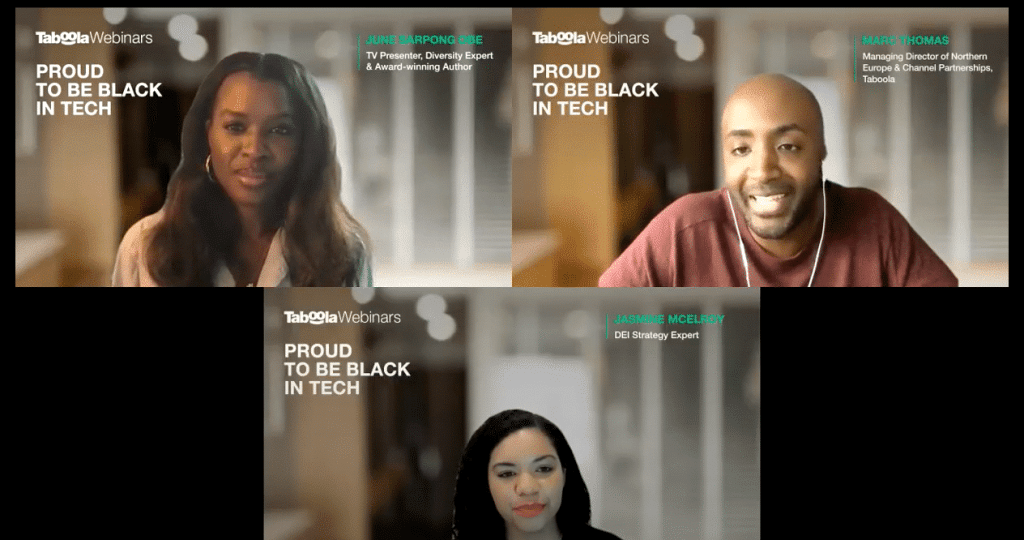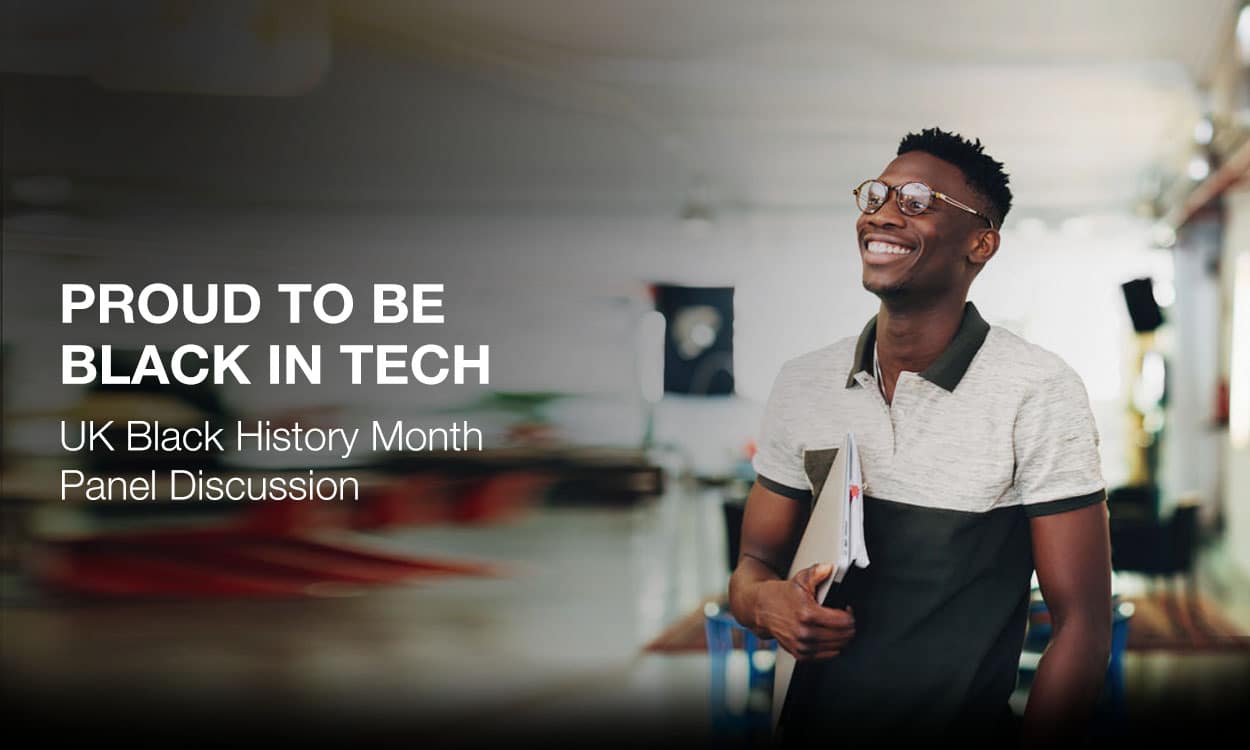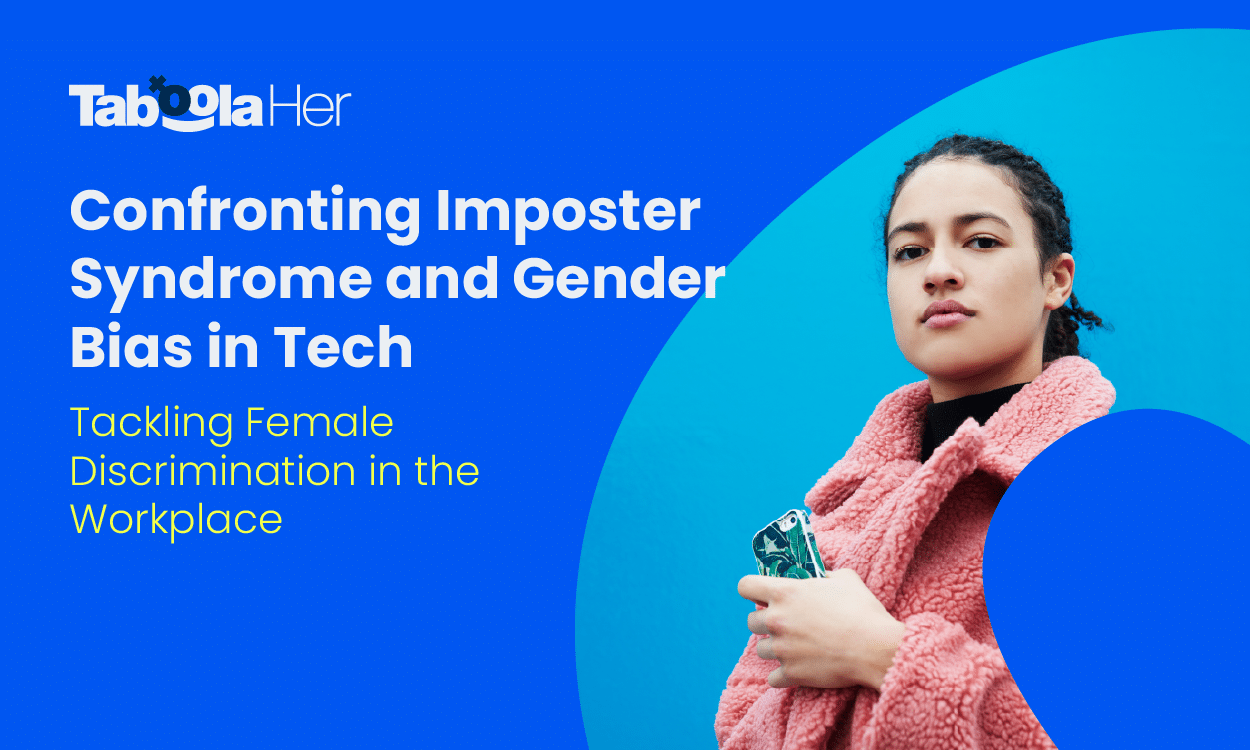The past year has seen greater visibility of and interest in initiatives related to Diversity, Equity, and Inclusion (DEI). But have these initiatives made a difference in the advertising, creative and tech industries?
Under the official UK Black History Month 2021 theme, “Proud to Be Black in Tech”, Marc Thomas, Managing Director of Taboola’s EMEA region, posed that and other questions in a fireside chat with June Sarpong OBE, TV Presenter, Diversity Expert & Award-winning Author and Jasmine McElroy, Diversity & Inclusion Strategist.

Here are their insights on the current state of DEI in the entertainment and tech industries and how organizations can better create a truly inclusive workplace culture.
1. Representation behind the camera is lacking
Speaking from her extensive experience in the TV and media, Sarpong kicked off our candid conversation with insight into these industries. Sarpong expressed that Black representation on TV has increased over the past few years; however, it is still lacking behind the scenes.
In the past, you could count the number of Black actors getting leading or supporting roles on TV on one hand, comments Sarpong. Things have come a long way since then, but she says there’s still a lack of representation when you think about who’s making and directing TV programming.
“Where there is a huge problem still is behind the camera. The numbers are minuscule in terms of diverse talent actually writing, directing, and producing shows. And even those that are there haven’t been given the types of opportunities that they deserve. So there’s a long way to go.” – June Sarpong
However, Sarpong does see the artistic freedom given to people like director and producer Michaela Coel as a sign that things are slowly moving in the right direction.
2. The stars behind what you read, listen to, and watch, are diverse beyond the color of their skin
While there may be more Black representation in the media, McElroy says there’s still a lack of understanding of what that representation really means to viewers out there. To be truly representative, she suggests, program makers need to think about intersectionality:
“Black people are not a monolith. Are we thinking about other identities, LGBTQ+ people, people with disabilities? I think there’s a lot that has been done, but there’s a lot more that needs to be done.” – Jasmine McElroy
3. Inclusion is necessary for future-proofing
Both speakers agreed that most companies in the tech and media world weren’t created with inclusion in mind, and many have achieved success with largely homogeneous teams. But with changing demographics, Sarpong comments, this needs to change, otherwise organizations risk getting left behind.
“It becomes about future-proofing your organization. The fact is that the world is changing. By 2030, over 40% of the world’s young people will be from Africa. So if you are a global business, you better think about what your response is to that. This new generation is not going to accept the old sort of colonial way of doing things.” – June Sarpong
4. Leadership needs to immerse themselves into the Black experience
Sarpong adds that a prerequisite for supporting Black talent in tech is a new approach from leadership.
“Take some time to get to know some Black people. Put yourself in an environment where you are the only one [like you] in the room, and get comfortable being uncomfortable. You’ll understand what your colleagues experience daily when they are in boardrooms. That will inform how you then apply that in the workplace. And it will come much more naturally than something that’s just a box ticking exercise.” – June Sarpong
5. Focus on wellness and psychological safety
McElroy adds that leaders must also create psychologically safe spaces where people who identify as Black can share their views. However, she cautions against putting the onus on Black people to deliver diversity solutions.
“Black people didn’t create racism. So I think it shouldn’t be on us to fix it.” – Jasmine McElroy
She adds: “If you’re benefiting from the system, whether you’re the top level leader, somewhere in the middle or an individual contributor, there is something you can do. And starting with creating safe spaces to ask those questions and brainstorm will definitely help.”
6. Modeling inclusive leadership is key
Sarpong is clear that those in positions of power in the business world should lead by example to create more inclusive environments down the chain. But she cites England football manager Darren Southgate as a good example of both leadership and allyship:
“He saw the racism that his colleagues experienced when he was a football player, and as a leader he doesn’t shy away from this issue. The lads talk about racism and white colleagues and players truly take on board what their Black colleagues experience. And as a result of that, when something happens, they stand together.” – Darren Southgate
7. Allyship has to be active
“You are not an ally until you’re accepted as an ally. You are an aspiring ally.” – Jasmine McElroy
Both speakers believe that being ally means actually doing something.
For Sarpong, allyship in business is about seeing people of color as equals and doing the work to advocate on their behalf: “As someone that sees yourself as an ally, you are going to identify whatever barriers there may be, even in your department, that may prevent a colleague of color progressing, and you are going to work to remove that barrier. Even if that’s all you do, that makes a difference.”
And McElroy adds that you can be an effective ally even if you’re not in a leadership role: “Sometimes people are like, ‘well, I’m not a leader. What can I do?’ Share information with your Black colleagues.” For example, lack of transparency in salary information often disadvantages Black colleagues. Sharing this information can break down that barrier.
8. Improve access to mental health resources
Sarpong acknowledges the mental stress caused by racism, especially some of the covert racism Black people experience today, but she also pays tribute to Black people’s resilience in thriving against unbelievable odds. That said, it’s important to look at the impact.
McElroy agrees, and says that it’s a huge misconception to see a focus on mental wellness as something negative: “Focusing on wellness is not a thing of weakness at all. It’s very much strength based.” She’d like to see business focus on increasing access to mental health resources for Black people, whether that’s on a person to person level or a company level.
9. Balance and open mindedness are key leadership traits for DEI improvements
Looking ahead to improving DEI, McElroy says that leaders need to know what they don’t know and use advisors to fill in any gaps. She adds that an open-minded, open-hearted approach will help positively influence DEI practice.
“What we need to see in terms of leadership style is a balance and appreciation of all traits and attributes. I think with that we won’t have the kind of unfair and unethical business practices that we sometimes see.” – June Sarpong
Get more insights on virtue signaling, tokenism and more in the full webinar recording. Register to watch now here!



